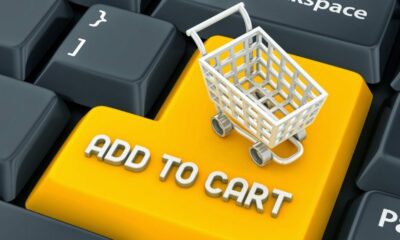SEO
Google AdSense Guide: increase earnings and escape low CPC

30-second summary:
- There are many factors that affect your AdSense performance right from content quality, ad placements, media selection, and so on
- High traffic doesn’t directly indicate high earnings, in fact, some of your practices may be equivalent to handing out money to your competition
- Here are six informed steps to help you earn more from AdSense
Throughout this guide, you’ll learn how to increase your Google AdSense earnings by making some very simple changes and by following a few simple tips. In my personal experience, this can help skyrocket your AdSense CPC and results can increase your AdSense earnings by more than five times.
Your aim and objective throughout should be to gradually increase your AdSense CPC and CTR little by little and by following these simple tips you are bound to see results.
Don’t forget to keep on testing and your AdSense earnings will surely increase over time. Just don’t give up quickly!
1. Content is king on the internet and also on AdSense
The reason content is placed at the top of all the other tips is because it is the single most important rule to follow on your journey through SEO and internet marketing. It is the first thing your visitors, advertisers, and bots (ad bots and crawl bots) will notice after coming to your webpage.
If you are providing your users with low quality or outdated content, Google will rate your website much lower and your CPC (the bids advertisers make to appear on your website) will greatly fall. This can also get you smart-priced, even if you generate quality traffic on low-quality content.
So remember, always provide your readers and visitors with something unique and worthwhile which will actually acknowledge rather than something which has already been posted on a thousand other websites.
2. Ad sizes and placements are decisive
Do not neglect the placement and size of your Google AdSense ads as they play an important into delivering a better user experience and thus, improving your AdSense earnings.
“While creating ad sizes and placements, user experience and ad viewability should be the center focus”, explained SEO expert Boris Dzhingarov, in an email interview.
“Some placements and ad sizes will disrupt users, particularly if they’re covering content. Others, however, will fail miserably as the users never see them leading to a decrease in AdSense revenues”, he added.
So the question now is: where should you place your ad and which of Google’s display ad sizes are best for your business? The answer is pretty simple, place two ads inside your blog posts (or content) and one outside the post. Keep one 336 x 280 large rectangle ad on the top of the blog post just below the title and place the second ad in the middle of the blog post as a 468 x 60 sized banner. The remaining unit can be placed to the right of your post inside your sidebar.
Position your AdSense ad units as such to not annoy your visitors by popping right in their faces. Instead, perfectly fit inside your content, or in positions that you aim to get more clicks from.
For example, a site that provides file downloads can have an AdSense Ad Unit right near the download link to get a High CTR.
3. Monitor and limit the use of AdSense ad units
Have you tried limiting the use of your AdSense ad units? The biggest difference I myself have noticed is that by reducing the ad units which had the lowest CTR you can quickly and easily increase your AdSense CPC.
What usually happens is if you don’t have enough content to support all the ad units is that lower-paying ads start showing on your websites. This may increase your click-through rate (CTR) and bring in more clicks but because the ads may not be relevant to your website (public advertisements). This results in your CPC falling and your AdSense earnings decreasing. If you are increasing your ad units ultimately you are making it easier for advertisers to be shown on your website meaning an even lower CPC (because of low bids).
Remove the low CTR ad units and replace them with the higher paying ad units which have a higher CTR and your earnings will rise automatically.
Trying these tips for a couple of days will make you notice a real improvement and an important increase in low AdSense CPC.
Google AdSense Custom Channels will be necessary to keep track of things. This will give you a precise and clear idea of the best-performing ad slots. Measure the CTR, CPC, CPM, and earning of every ad unit.
Create custom channels for every ad slot and monitor their performance for at least two weeks to get an idea of things. If you keep changing ad units too often without testing them thoroughly you might get inaccurate results and miss out on better opportunities by placing your ads elsewhere.
How this is going to help in increasing your AdSense CPC?
Remove the low-performing ad units from your website (Compare CTR and final earnings of different units). Google should now serve better ads to other remaining ad slots which are performing well, so your earnings and CPC will increase.
4. Enable both text and image, media-rich ads
Always enable both text and image ads on your websites. Never limit your ad visibility to ‘Only image/media-rich ads’ or ‘Only text ads’ as this will lower the bids for advertisers to appear on your website. This directly means low AdSense CPC.
If you enable ‘Both text and image ads’ AdSense will automatically show the ad with the highest bid on your website which means a higher CPC for you.
In short, the more advertisers that are bidding to appear on your website the higher your AdSense CPC will be.
5. Keywords, keywords, and more keywords!
Try researching to find keywords with ‘High AdSense CPC’ and a ‘High Search Volume’. Searched globally using the Google Adwords keyword tool. Search, search and search some more to find specific keywords which have low competition, high CPC, and high search traffic.
After researching you can start creating your website pages, blog posts, and articles on such high-value keywords. Always use these keywords naturally at the beginning, the middle, and the end of your content. It is also very useful to add them to your headings or tags.
Try not to bother with keywords that pay a few cents and those that have a low CPM. Ideally, I would recommend grabbing keywords with a CPC higher than $2.50.
This should be the most important part of your mission. You would never want a page that earns one dollar from five to 10 clicks. Rather you want a page that pulls an impressive four to five dollars out of just two ad clicks, or maybe even $40 dollars out of just eight clicks!
If you don’t concentrate on your keywords, even if you have a lot of traffic you will be wasting it and not earning a substantial amount. Imagine this as handing out money to your own competition! By targeting the right keywords you can make a lot more with a lot less traffic.
Research on the Google keyword tool today and increase your Adsense CPC and earnings.
6. Reduce fraud, accidental, and useless clicks
Do you have an ad unit placed near the top of your content that gets a high CTR? Can this also be because of the awkward location that some people end up clicking on your ad by mistake? When this happens, the visitors often back out or close the ad. This is counted by Google as either an accidental or fraud click.
You may temporarily get earnings from these clicks but they will most probably be reverted due to the low-quality nature of the click.
So always try to minimize any accidental or useless clicks on your AdSense ad units and NEVER ask your friends or family to click on your ads!
Jacob M. is a copywriter, marketing blogger, inbound marketing consultant, and founder of Write Minds. He can be found on Twitter @jmcmillen89.
Subscribe to the Search Engine Watch newsletter for insights on SEO, the search landscape, search marketing, digital marketing, leadership, podcasts, and more.
Join the conversation with us on LinkedIn and Twitter.
SEO
Google Declares It The “Gemini Era” As Revenue Grows 15%

Alphabet Inc., Google’s parent company, announced its first quarter 2024 financial results today.
While Google reported double-digit growth in key revenue areas, the focus was on its AI developments, dubbed the “Gemini era” by CEO Sundar Pichai.
The Numbers: 15% Revenue Growth, Operating Margins Expand
Alphabet reported Q1 revenues of $80.5 billion, a 15% increase year-over-year, exceeding Wall Street’s projections.
Net income was $23.7 billion, with diluted earnings per share of $1.89. Operating margins expanded to 32%, up from 25% in the prior year.
Ruth Porat, Alphabet’s President and CFO, stated:
“Our strong financial results reflect revenue strength across the company and ongoing efforts to durably reengineer our cost base.”
Google’s core advertising units, such as Search and YouTube, drove growth. Google advertising revenues hit $61.7 billion for the quarter.
The Cloud division also maintained momentum, with revenues of $9.6 billion, up 28% year-over-year.
Pichai highlighted that YouTube and Cloud are expected to exit 2024 at a combined $100 billion annual revenue run rate.
Generative AI Integration in Search
Google experimented with AI-powered features in Search Labs before recently introducing AI overviews into the main search results page.
Regarding the gradual rollout, Pichai states:
“We are being measured in how we do this, focusing on areas where gen AI can improve the Search experience, while also prioritizing traffic to websites and merchants.”
Pichai reports that Google’s generative AI features have answered over a billion queries already:
“We’ve already served billions of queries with our generative AI features. It’s enabling people to access new information, to ask questions in new ways, and to ask more complex questions.”
Google reports increased Search usage and user satisfaction among those interacting with the new AI overview results.
The company also highlighted its “Circle to Search” feature on Android, which allows users to circle objects on their screen or in videos to get instant AI-powered answers via Google Lens.
Reorganizing For The “Gemini Era”
As part of the AI roadmap, Alphabet is consolidating all teams building AI models under the Google DeepMind umbrella.
Pichai revealed that, through hardware and software improvements, the company has reduced machine costs associated with its generative AI search results by 80% over the past year.
He states:
“Our data centers are some of the most high-performing, secure, reliable and efficient in the world. We’ve developed new AI models and algorithms that are more than one hundred times more efficient than they were 18 months ago.
How Will Google Make Money With AI?
Alphabet sees opportunities to monetize AI through its advertising products, Cloud offerings, and subscription services.
Google is integrating Gemini into ad products like Performance Max. The company’s Cloud division is bringing “the best of Google AI” to enterprise customers worldwide.
Google One, the company’s subscription service, surpassed 100 million paid subscribers in Q1 and introduced a new premium plan featuring advanced generative AI capabilities powered by Gemini models.
Future Outlook
Pichai outlined six key advantages positioning Alphabet to lead the “next wave of AI innovation”:
- Research leadership in AI breakthroughs like the multimodal Gemini model
- Robust AI infrastructure and custom TPU chips
- Integrating generative AI into Search to enhance the user experience
- A global product footprint reaching billions
- Streamlined teams and improved execution velocity
- Multiple revenue streams to monetize AI through advertising and cloud
With upcoming events like Google I/O and Google Marketing Live, the company is expected to share further updates on its AI initiatives and product roadmap.
Featured Image: Sergei Elagin/Shutterstock
SEO
brightonSEO Live Blog

Hello everyone. It’s April again, so I’m back in Brighton for another two days of Being the introvert I am, my idea of fun isn’t hanging around our booth all day explaining we’ve run out of t-shirts (seriously, you need to be fast if you want swag!). So I decided to do something useful and live-blog the event instead.
Follow below for talk takeaways and (very) mildly humorous commentary. sun, sea, and SEO!
SEO
Google Further Postpones Third-Party Cookie Deprecation In Chrome

Google has again delayed its plan to phase out third-party cookies in the Chrome web browser. The latest postponement comes after ongoing challenges in reconciling feedback from industry stakeholders and regulators.
The announcement was made in Google and the UK’s Competition and Markets Authority (CMA) joint quarterly report on the Privacy Sandbox initiative, scheduled for release on April 26.
Chrome’s Third-Party Cookie Phaseout Pushed To 2025
Google states it “will not complete third-party cookie deprecation during the second half of Q4” this year as planned.
Instead, the tech giant aims to begin deprecating third-party cookies in Chrome “starting early next year,” assuming an agreement can be reached with the CMA and the UK’s Information Commissioner’s Office (ICO).
The statement reads:
“We recognize that there are ongoing challenges related to reconciling divergent feedback from the industry, regulators and developers, and will continue to engage closely with the entire ecosystem. It’s also critical that the CMA has sufficient time to review all evidence, including results from industry tests, which the CMA has asked market participants to provide by the end of June.”
Continued Engagement With Regulators
Google reiterated its commitment to “engaging closely with the CMA and ICO” throughout the process and hopes to conclude discussions this year.
This marks the third delay to Google’s plan to deprecate third-party cookies, initially aiming for a Q3 2023 phaseout before pushing it back to late 2024.
The postponements reflect the challenges in transitioning away from cross-site user tracking while balancing privacy and advertiser interests.
Transition Period & Impact
In January, Chrome began restricting third-party cookie access for 1% of users globally. This percentage was expected to gradually increase until 100% of users were covered by Q3 2024.
However, the latest delay gives websites and services more time to migrate away from third-party cookie dependencies through Google’s limited “deprecation trials” program.
The trials offer temporary cookie access extensions until December 27, 2024, for non-advertising use cases that can demonstrate direct user impact and functional breakage.
While easing the transition, the trials have strict eligibility rules. Advertising-related services are ineligible, and origins matching known ad-related domains are rejected.
Google states the program aims to address functional issues rather than relieve general data collection inconveniences.
Publisher & Advertiser Implications
The repeated delays highlight the potential disruption for digital publishers and advertisers relying on third-party cookie tracking.
Industry groups have raised concerns that restricting cross-site tracking could push websites toward more opaque privacy-invasive practices.
However, privacy advocates view the phaseout as crucial in preventing covert user profiling across the web.
With the latest postponement, all parties have more time to prepare for the eventual loss of third-party cookies and adopt Google’s proposed Privacy Sandbox APIs as replacements.
Featured Image: Novikov Aleksey/Shutterstock
-

 PPC7 days ago
PPC7 days ago19 Best SEO Tools in 2024 (For Every Use Case)
-
SEARCHENGINES6 days ago
Daily Search Forum Recap: April 19, 2024
-
SEARCHENGINES7 days ago
Daily Search Forum Recap: April 18, 2024
-

 WORDPRESS6 days ago
WORDPRESS6 days agoHow to Make $5000 of Passive Income Every Month in WordPress
-

 SEO7 days ago
SEO7 days ago25 WordPress Alternatives Best For SEO
-

 WORDPRESS5 days ago
WORDPRESS5 days ago13 Best HubSpot Alternatives for 2024 (Free + Paid)
-

 WORDPRESS6 days ago
WORDPRESS6 days ago7 Best WooCommerce Points and Rewards Plugins (Free & Paid)
-

 MARKETING6 days ago
MARKETING6 days agoBattling for Attention in the 2024 Election Year Media Frenzy
















You must be logged in to post a comment Login